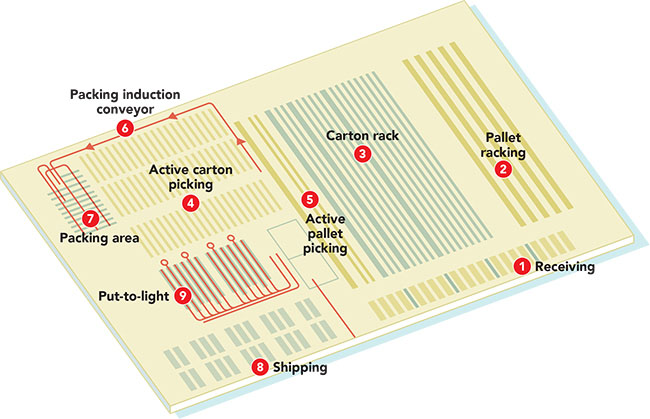lululemon: Embracing automation for e-commerce fulfillment
WMS, lights, voice and conveyors bring a new level of efficiency to lululemon athletica’s Ohio distribution center.
lululemon athletica
Groveport, Ohio
Size: 310,000 square feet
Products: Yoga and athletic wear
SKUs: 7,000 with capacity of up to 20,000 SKUs
Throughput: 4,000 orders per day
Employees: 50 employees expanding to 200 when fully functional
Shifts per day/days per week: 2 shifts per day, 5 days per week
The yoga wear retailer’s new 310,000-square-foot distribution center near Columbus, Ohio, is a testing ground for automation. Lululemon’s system features a combination of conveyor, sortation, put-to-light and voice technology, all directed by a warehouse management system (WMS).
Receiving: Receiving is initiated when advanced ship notifications are fed into the WMS. Newly received product is unloaded to an extendable conveyor and delivered to the receiving area (1). When the cartons are scanned, the WMS directs the receiver to sort the merchandise by the next task and distribution channel. Next task, for example, includes merchandise that might require dimensional scanning, quality assurance or a value-added service before putaway. Similarly, the product may be staged for storage in a pallet racking area (2) or a carton rack area (3). Once product is ready for putaway, the WMS directs a wire-guided lift truck operator to the right storage location. The operator scans a location to confirm putaway.
Replenishment: Wire-guided lift truck operators are directed by the WMS to pull merchandise from reserve stock locations (2,3). Those items are then delivered to a pick location in the active carton (4) and active pallet picking areas (5). Pick locations are confirmed by a bar code scan.
E-commerce picking, packing and shipping: The WMS creates picking waves for single line and multi-line orders. Voice technology directs order selectors in the active pick shelving area (4). Single line orders are picked into a large tote that consolidates up to 35 orders per tote; multi-line orders are picked to a cart that holds up to 16 smaller totes in a single pass through a picking area. Once a tote is complete, the order selector inducts the tote onto the e-commerce packing induction conveyor (6). Following an automatic scan, the WCS diverts totes to the appropriate lane in the packing area (7) for that order: Single line orders are packed using an autobagger; multi-line orders are packed manually.
Once packing is complete, an operator inducts a package onto the carton sortation conveyor. The sorter diverts the package to the right shipping lane (8) for that order. Once the truck is picked up by FedEx, the order is closed out in the WMS. That information is then fed to the order management system, which triggers payment confirmation and sends a shipment notification to the customer.
Store picking, packing and shipping: Stores receive two types of deliveries: new styles that are allocated to the stores and replenishment orders of existing styles. Each delivery type has its own picking, packing and shipping process. It’s important to note that over 99% of orders are re-packs and new styles are delivered to the stores weekly.
New SKUs: Orders for new styles are fed into the WMS, which creates a picking wave. These can include full cartons and mixed cartons.
Full cartons are picked in the carton rack storage area (3). There, associates operating wire-guided lift trucks are directed by the WMS to a pick location, which is confirmed by scanning. Full pallets are delivered to the shipping area (8).
Mixed cartons orders are picked in a put-to-light area (9). The WMS sends carton information to an associate who inducts the right carton for an order onto the carton sortation conveyor. The WCS diverts the carton to the corresponding put-to-light lane. When the carton arrives in the zone, the carton label is automatically scanned. The bins with items for that carton are illuminated, along with the number of items to be picked. Once the associate packs the carton, it is inducted back onto the carton sortation conveyor. Following another automatic scan, the carton is conveyed to an inline scale where the weight is recorded and sent to the WMS. The WMS determines the best way to ship the carton and creates a shipping label, which is automatically applied. The sorter then diverts the carton to a shipping lane (8).
Existing SKUs: Before picking for existing styles is initiated, merchandise is pulled from the carton rack storage (3) and moved to carton flow racking located in the active carton picking area (4). Associates are directed by the WMS to pick replenishment stock to a wire-guided lift. That inventory is then delivered to a pick location in the carton flow rack and confirmed by scanning a location label.
Once the carton flow rack area is stocked, pick waves are created in the WMS. Associates are directed by voice to pick to carts. Each associate can pick up to 12 cartons/orders in a single pass through the pick zone. Once all of the items have been picked, the associate inducts the cartons onto the carton sortation conveyor. As new items, cartons are automatically weighed and a shipping label is created and automatically applied before cartons are sorted to the right shipping lane (8).
In both instances, the load is closed in the WMS when the carrier picks up an order. The information is fed to the enterprise resource planning (ERP) system, which triggers a store shipment notification.
System suppliers
System design, integration, warehouse control system, carton sortation, put-to-light system & pack stations: SDI
Carton conveyor: Intelligrated
MDR conveyor: Hilmot
Belted curves: Transnorm
Extendable conveyors: Best Conveyors
WMS: Manhattan Associates
Mobile computing and scanning: Motorola Solutions
Label printing: Zebra Technologies
Case scanners: SICK
Mezzanine: Steele Solutions
Voice recognition: Honeywell—Vocollect Voice Solutions
Carton and pallet rack and shelving: Steel King Industries
Inline scale: OCS Technologies
Dimensional cubing: CubiScan
E-commerce autobagger: Sharp Packaging Systems
Lift trucks and order pickers: Raymond Corp.,
Network design study: FedEx













